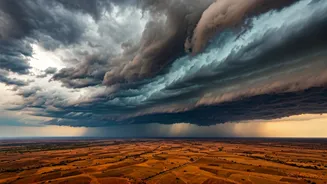Weather Pattern Shifts
The atmospheric conditions in India are undergoing a transformation, with a prediction that the weather will become more intense during the upcoming week.
This information points towards a period where various factors, such as wind patterns, temperature fluctuations, and moisture content, will interact to create severe weather. Although the specific nature of these shifts hasn't been completely revealed in the source material, the warning implies the possibility of extreme weather events. The significance of this change demands careful attention to weather updates and a readiness to respond appropriately to any hazards. Understanding these dynamics is crucial for making informed decisions regarding safety and everyday planning.
Impact & Consequences
When weather conditions turn severe, a number of potential consequences can arise. The implications can reach far beyond the immediate discomfort of the populace. Severe weather can disrupt infrastructure, leading to power outages, damage to transportation networks, and even the disruption of essential services. Moreover, such conditions pose significant risks to human health and safety, increasing the probability of weather-related injuries or fatalities. Economic activities may also be hit. For example, agriculture could suffer due to flooding, heat waves, or other conditions. These are a few of the potential impacts of severe weather in India and highlight the significance of advance warning and proper preparation.
Public Safety Measures
In anticipation of the severe weather, proactive steps are essential to safeguard the well-being of the public. This means keeping abreast of the latest weather reports provided by reliable sources, like the India Meteorological Department. Staying informed allows people to take preventative measures in a timely manner. Secondly, it is critical to prepare for the specific types of conditions predicted, which could include having an emergency kit ready. This kit must include essentials like clean water, non-perishable food items, a first-aid kit, and any necessary medications. Furthermore, residents should follow instructions given by local authorities. Such guidelines are designed to minimize risks and ensure that everyone is prepared and protected during severe weather conditions. Proper preparation is essential to reduce negative impacts.
Regional Variations Expected
Given the vast size of India, it is highly likely that the severity and the nature of the weather will vary across different regions. Specific areas may face particular hazards depending on their geographical characteristics and local weather patterns. For example, coastal regions could experience heavy rainfall and flooding, while northern areas might face extreme cold or heat waves. The variations highlight the need to tailor preparations and precautions according to the localized forecasts. The focus of the authorities and the public needs to be on staying informed about specific regional weather conditions. This will help them to respond efficiently to any potential threats. Being aware of the local weather pattern will help ensure safety and efficient management of resources.
Long-Term Adaptation Strategies
Looking beyond the immediate weather forecasts, it is important to think about the long-term changes that can help India to adapt to more severe weather conditions. This includes strengthening infrastructure to withstand the impacts of the weather. Building homes, roads, and utility systems to be more resilient will reduce the damage caused by extreme weather. Furthermore, promoting climate-smart agricultural practices can enhance the ability of farmers to deal with droughts, floods, and other challenges. Investing in early warning systems is another crucial step, so that communities will have time to prepare for any potentially hazardous weather. These approaches will aid in lessening the impact of severe weather on India, encouraging safety, and also supporting sustainable development over the long term.

















